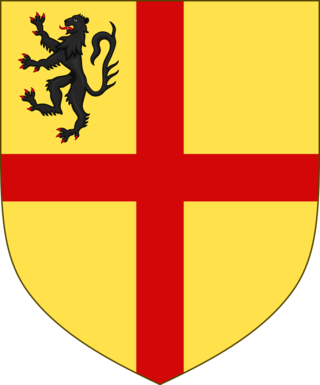Related Research Articles

West Connacht was a kingdom of Gaelic Ireland, associated geographically with present-day County Galway, particularly the area known more commonly today as Connemara. The kingdom represented the core homeland of the Connachta's Uí Briúin Seóla kindred and although they ruled, there were smaller groups of other Gaels in the area, such as the Delbhna Tir Dha Locha and the Conmhaícne Mara. It existed from 1051 onwards, after the Ó Conchobhair, Kings of Connacht, pushed the Ó Flaithbheartaigh to the West of Lough Corrib, from their original territory of Maigh Seóla. Iar Connacht remained a subordinate túath of Connacht, until the 13th century, after which it was more independent.

Sir Uilleag (Ulick) de Burgh (Burke), 1st Clanricarde or Mac William Uachtar was an Irish chieftain and noble who was leader of one of the three factions who fought the Burke Civil War in the 1330s. By the end of the conflict he had established himself and his descendants as Clanricarde, also known as Mac William Uachtar, independent lords of Galway. He was succeeded by his son, Richard Óg Burke, 2nd Clanricarde (d.1387).

The O'Conordynasty are an Irish noble dynasty and formerly one of the most influential and distinguished royal dynasties in Ireland. The O'Conor family held the throne of the Kingdom of Connacht up until 1475. Having ruled it on and off since 967, they ruled continuously from 1102 to 1475. Moreover, the O'Conor parent house the Uí Briúin and Síol Muireadaigh ruled Connacht on many occasions – but not continuously – between 482 and 956. The house of O'Conor also produced two High Kings of Ireland, Tairrdelbach Ua Conchobair and his son Ruaidrí Ua Conchobair, the last High King of Ireland. The family seat is Clonalis House outside Castlerea in County Roscommon.

The Ó Dálaigh were a learned Irish bardic family who first came to prominence early in the 12th century, when Cú Connacht Ó Dálaigh was described as "The first Ollamh of poetry in all Ireland".
James Daly, 1st Baron Dunsandle and Clanconal was an Irish politician.

Denis Daly of Carrownakelly and Dunsandle Castle, Loughrea, County Galway, was an Irish landowner and politician.
Patrick D'Arcy (1598–1668) was an Irish Catholic Confederate and lawyer who wrote the constitution of Confederate Ireland.
Rickard de Bermingham, otherwise Rickard Mac Fheorais, was Anglo-Irish lord of Athenry.
Richard II de Bermingham was an Anglo-Irish lord.
Edward de Bermingham, Anglo-Irish lord of Athenry and Dunmore, County Galway, died 1709, was the son of Francis de Bermingham, 12th Baron Athenry and Bridget, daughter of Sir Lucas Dillon. He succeeded as 13th Baron Athenry in 1677.
Murrough mac Toirdelbach Ó Briain, Chief of the Name, the Clan Tiege of Aran, fl. 1575 – 1588.
Robert Daly was Church of Ireland Bishop of Cashel and Waterford from 1843 to 1872.
Sir Dermot Ó Seachnasaigh, Chief of the Name, died 1606. He was a son of Sir Ruaidhrí Gilla Dubh Ó Seachnasaigh and Lady Honora O'Brien, daughter of Murrough O'Brien, 1st Earl of Thomond.
Denis Daly, was an Irish landowner, Judge and Privy Councillor.
Geoffrey Browne was an Irish lawyer and politician.
Denis Bowes Daly PC was an Irish politician.
James Daly was an Irish Member of Parliament.
Flann Óc mac Séoan Ó Domhnalláin was Ollamh Síol Muireadaigh for an unknown time in 1404.

Ulick Fionn Burke, 6th Clanricarde or Mac William Uachtar was an Irish chieftain and noble.
John Lambert of Creg Clare was an Irish soldier and Royalist.
References
- BLAKE, MARTIN J. “Families of Daly of Galway with Tabular Pedigrees.” Journal of the Galway Archaeological and Historical Society 13, no. 3/4 (1927): 140–140.
- As The Centuries Passed: A History of Kiltullagh 1500–1900, ed. Kieran Jordan, 2000
- The life and times of Dermot O'Daly, James Noel Dillon.
- The Killimor Dalys, James Noel Dillon
- The Daly Chronicle, Dermot Daly, in The Irish Genealogist, volume 11, part i, 2002, pp. 3–12.
- Clare Bards, Galway Gentry, Patrick Melvin, op. cit., pp. 13–15